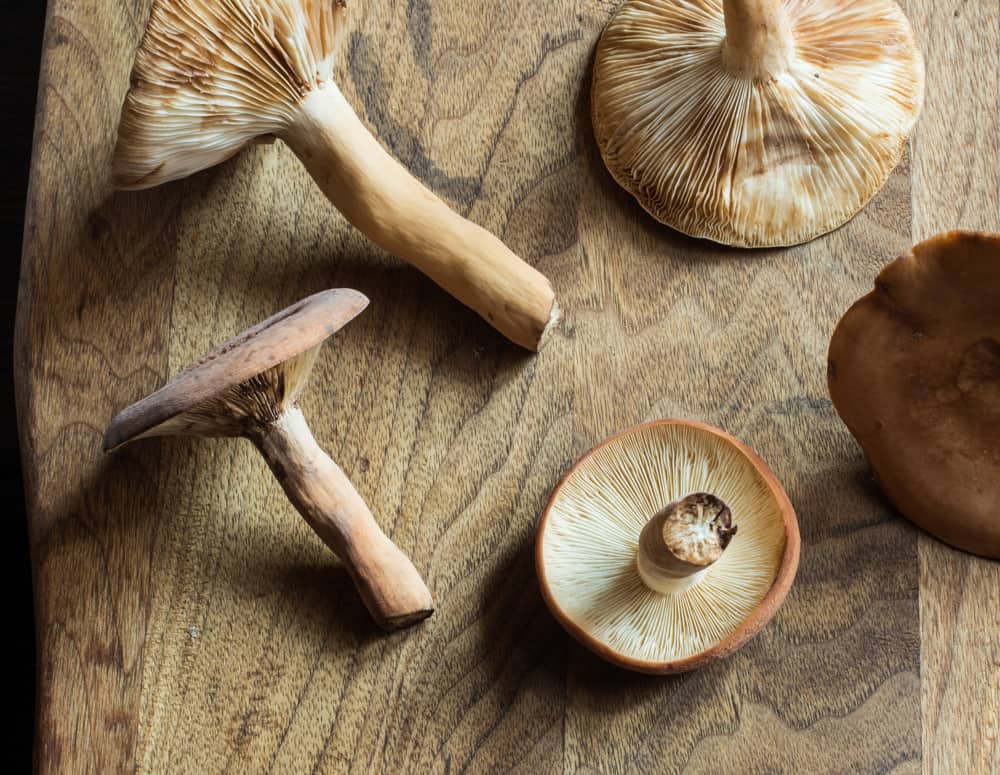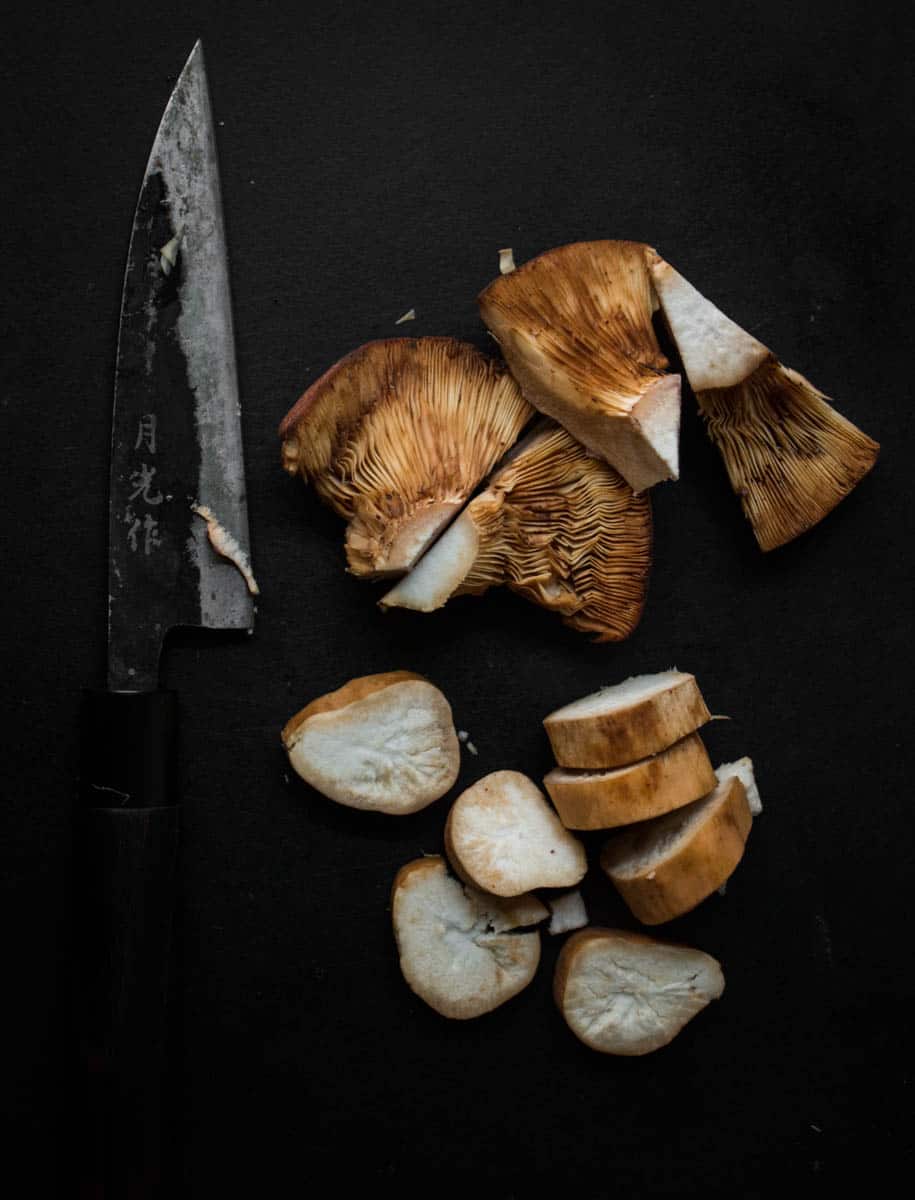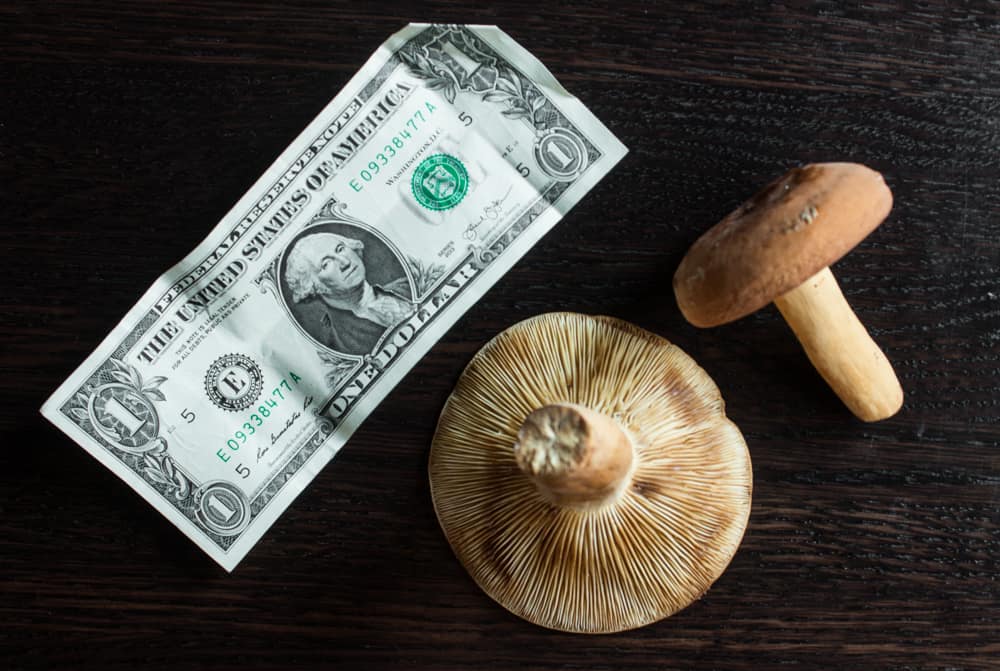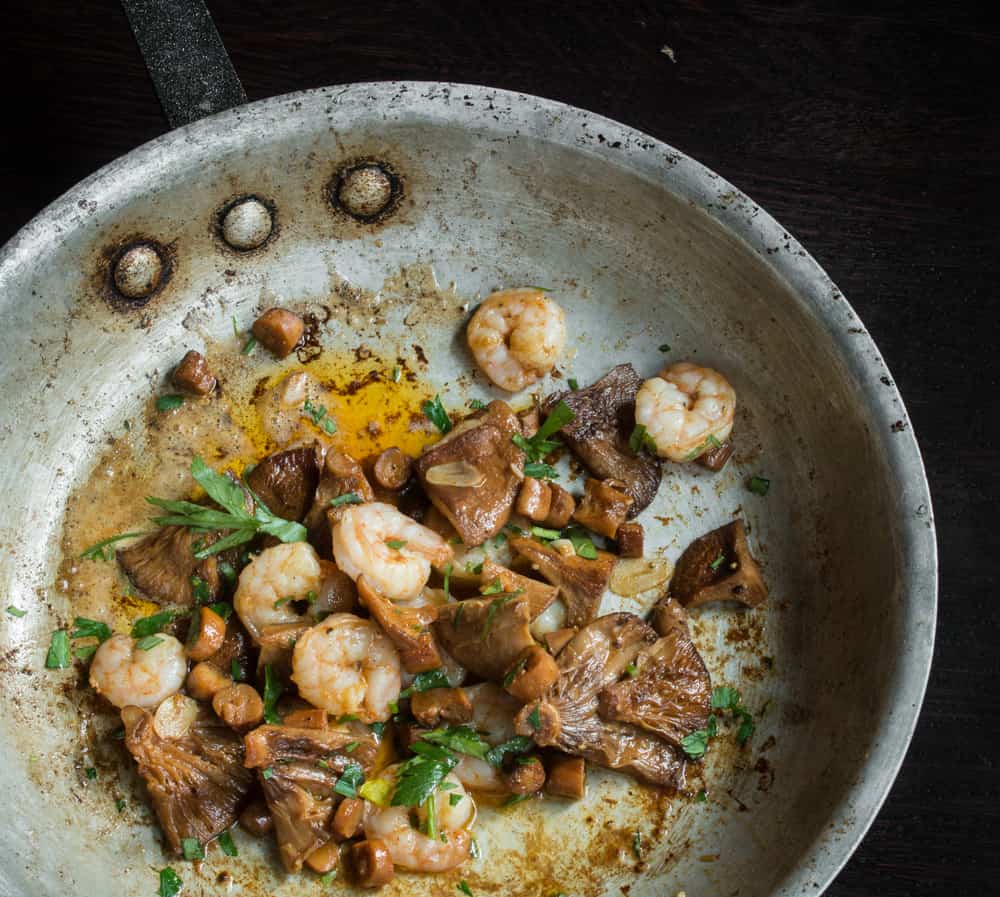One of the best milkcap mushrooms for the table. Lactifluus volemus (also known as the leatherback mushroom) is easy to identify, and has a great meaty taste. But, the first thing most people notice is their aroma. Read on and I'll share what I know about them.

I'm lucky and grateful to have a network of friends that hunt different plants and mushrooms. We share information on places we've hunted, seasonal changes, what's coming up when, and it helps to have company sometimes since mushroom hunting is for the most part a solitary sport.
Last year my friend Michael brought me by a bag of Lactifluus volemus, (formerly Lactarius volemus) with the caveat that I keep my eyes peeled for a few mushrooms he needs photography specimens of to include in his book. Scouring the land for individual species of shrooms is a lot easier said than done, mushrooms from the genus Lactarius can be some of the trickier ones to find when you need them.

He dropped off a bag a couple bags of them, and mentioned something about their aroma, which my line cooks were quick to describe with colorful adjectives revolving around intercourse and bodily fluids. Lets just say that you can use the fishy smell as a way to help identify them.
In the summer, after picking on a hot day and put into a warm car, you may need to roll the windows down, but when they hit the pan the smell transforms into a rich, nutty flavor. They're one of the best of the Lactifluus family I've tasted, and I'll say I might prefer them to any of the L. delicious (saffron milkcap) group that I've had so far, well, with the exception of Lactarius thyinos.

Habitat
I've been able to pick them growing spots at a number of different places, most of the time they seem to like the same habitat as lobster mushrooms and black trumpet mushrooms, which will be mixed deciduous hardwoods around the Twin Cities and Midwestern Minnesota.
In Northern Minnesota you'll likely see them with various conifers, but I have yet to find them up there. I often see them in chanterelle patches, too. They're widely distributed across North America in hardwood forests during the summer.

Various ID Characteristics
I don't usually do ID run-downs, but these have so many particular, easy to notice differences than a lot of other mushrooms I thought It could be helpful.
Smell
The first thing to know is that you may actually smell these before you taste them. Volemus have a very strong aroma, and I'll often catch it on the wind when they're near. It's a cheesy, fishy scent, and you'll know it when you smell it.
Spore Print
Lactifluus volemus has a white spore print.
Latex
These give off a profuse white latex when cut, a characteristic of milk cap mushrooms. Volemus has a kind of unsettling quality in that when you cut it, it doesn't drip-drop latex, it oozes latex, all over the place. This is why they're also known as the weeping milkcap.

As weird as the latex might look, romaine lettuce technically gives it off too, so don't let it weird you out too much. Know too, that you can also use latex to help you identify qualities of the mushroom in the field, as some will taste hot, bitter, etc. Volemus latex is white, thin, copious, tastes mild, and dries brown on the mushrooms.

Look alikes
There's a few mushrooms that resemble L. volemus. You'll want to compare your mushrooms with Lactifluus corrugis and Lactifluus hygrophoroides to ensure 100% ID. All of the aforementioned mushrooms are edible.
Cooking
David Arora says they're one of the best eating mushrooms in North America. While I had them in the restaurant I cooked them alongside a selection of summer mushrooms for a few fungi loving guests, the volemus as well as fragrant black trumpet mushrooms (Craterellus foetidus and cinereus) beat all other mushrooms I served them with: boletes, chanterelles, lobster mushrooms, club fungus, chicken of the woods. Like I mentioned their smell completely goes away cooking, it gets nutty, pleasant and mild.
Recipes
Here's a recipe that highlights their slightly fishy/cheesy quality, and a few others made for milkcaps, or where they could easily be substituted. Lactifluus Volemus with Smoked Paprika, Garlic, Parsley and Shrimp
- Catalan Saffron Milkcaps
- Wild Mushroom Conserve
- Wild Mushroom Duxelles
- Pickled Milkcaps
- Milkcaps Preserved In “Holy Oil”
- Turkish Saffron Milkcaps With Cumin Yoghurt
- Fricando Of Veal With Saffron Milk Caps
- Wild Mushrooms With Garlic And Parsley


Patty D
What an intriguing post! I never knew about the Voluminous Milk Cap and its culinary potential. Thanks for sharing your expertise!
Jules
I've found some of these, but never as many as I want! The last time, I found a nice big cap that remained curved under and hadn't gone funnel-shaped yet, and let me tell you, friend, listen carefully, because what I did made my toes curl, it was so good. Best damn mushroom I've ever eaten in my life. I stuffed it with breadcrumbs, herbs and spice, bit of parmesan I think, and baked it. And it was so gorgeous. I stuffed it and baked it because I saw an Eastern European person say that that's how they traditionally cooked it, and who can argue with tradition? I tried sauteing a few of these, and it was kind of meh, but baked? Food of the gods!
Alan Bergo
I think they're excellent mushrooms. I'll have to try baking them.
Christopher
Picked and enjoyed these wonderful natural gifts during the summer in the Western North Carolina mountains during the 1960's and early 1970's. They seem to have have all but disappeared. My hopes are that we did not bring about extinction in our area by annual harvesting. I sure miss them. I have searched on the internet for a place to purchase however have been unsuccessful. Any leads would be appreciated.
Wenzday
I found some today in North Carolina near Statesville!
Will K
One of my all-time favorite mushrooms! The first summer I started collecting wild mushrooms in earnest, these and L. corrugis were the most abundant mushroom I found. I haven’t seen them fruit like that since. I still call them Lactarius (old habits die hard). Great sounding recipe!
Will
Alan Bergo
I know, old habits die hard, when can we stop changing all the darn names? lol.
Dan
With DNA sequencing, it will happen. We will stop changing names, but we will be dead then. Our children can enjoy the stability.
Mary Jenn
I found the recipe with shrimp a little too rich, so I combined both (to add vegetables), added abrorio rice and vegetable stock to make a risotto. Thanks for sharing the recipe!
Alan Bergo
It is a rich recipe, it's meant to be a small bite, or the base of another dish, I should probably flesh that out a little more. Thanks Mary.
Lucy
Are you aware of any look-a-likes that also grow in the same conditions/same general location this time of year? After reading this, I think I may have found some last week. White latex when cut, but no bruising in the minute or so I observed it. I didn't notice a smell...does that take a little while to develop?
Alan Bergo
I don't know of any off hand, sorry.
Erik Jones
Two edible milkcaps that are similar-looking to Lactifluus volemus are Lactifluus corrugis and Lactifluus hygrophoroides. These grow in the same type of habitats, in fact, I rarely seem to find one of them without one or both of the others. L. corrugis has a darker brown cap with a white "bloom" and gills that are tawny/orangish even before bruising. L. hygrophoroides looks very much like L. volemus but has widely spaced gills instead of quite close ones--and doesn't stain brown as quickly or prominently. All three are good edibles (I think L. volemus is probably the best, it's the strongest-smelling and it seems to me to have richer flavor) and all three share the copious milk and brown-staining gills. I don't know whether these two grow in Minnesota or not, but I'm finding them ubiquitously in oak woods in Georgia.
As far as inedible lookalikes I've noticed some kind of incredibly acrid peppery milkcap which also co-occurs with L. volemus, and can look plausibly like L. volemus as a young button in the leaf litter. But the stalk is pure white, not buff/brown, and the milk is scanty and doesn't stain brown, so the danger of confusing them is not great for the observant.